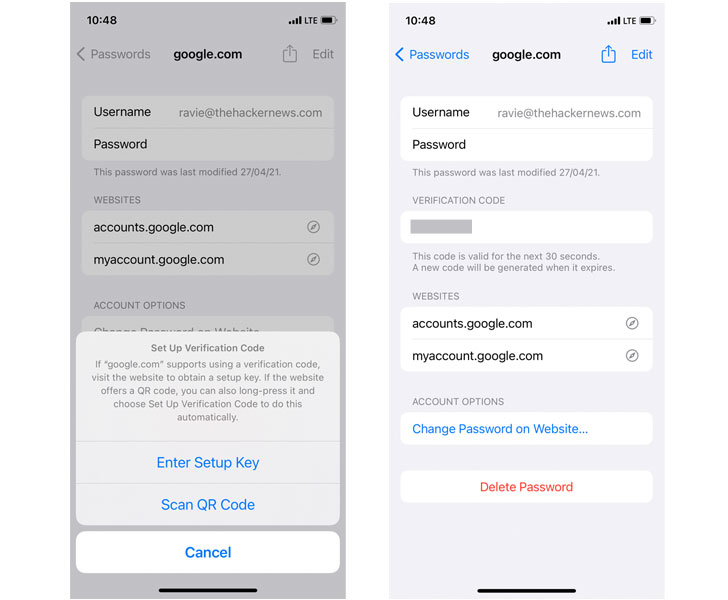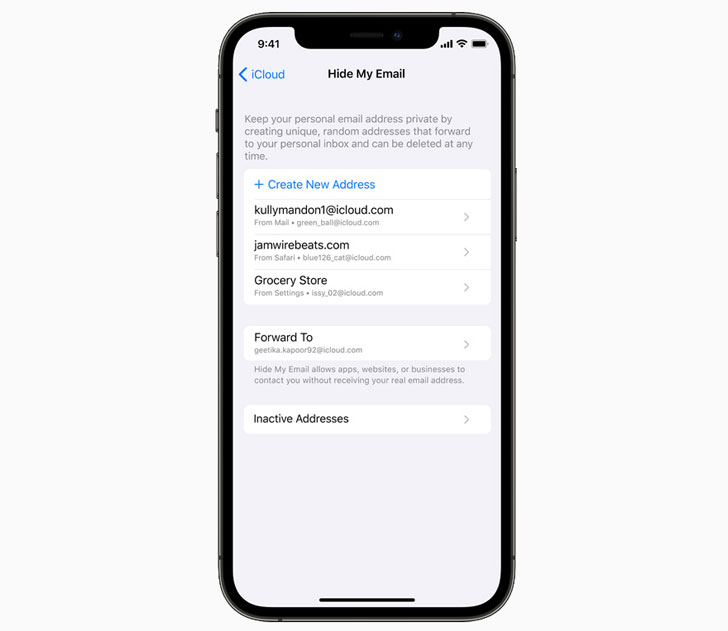Apple on Monday announced a number of privacy and security-centric features to its upcoming versions of iOS and macOS at its all-online Worldwide Developers Conference.
Here is a quick look at some of the big-ticket changes that are expected to debut later this fall:
1 — Just Patches, Not Entire OS Update Every Time: As rumored before, users now have a choice between two software update versions in the Settings app. Users can either opt to update to the latest version of iOS 15 for all the latest features and most complete set of security updates or continue on iOS 14 and still get important security updates until they are ready to migrate to the next major version.
2 — Built-in 2-Factor Authenticator: The new versions of iOS and macOS come with new options that allow users to generate two-factor authentication codes for each of the online accounts saved to iCloud Keychain (Settings > Passwords) without the need for downloading additional apps like Google Authenticator or Authy.
3 — Private Relay: To come as part of Apple iCloud+ for existing iCloud subscribers at no extra cost, Private Relay is akin to a VPN in that it routes users' internet traffic on Safari browser through two relays in order to mask who's browsing and where that data is coming from.
Unlike traditional VPNs who are still privy to users' real IP addresses and the websites they visit, iCloud Private Relay employs a dual-hop architecture that effectively shields IP address, location, and browsing activity that can be used to create a detailed profile.
The feature ensures that traffic leaving the device is encrypted before forwarding the requests through two internet relays, thus creating a simplified version of Tor, which employs at least a minimum of three relays to achieve anonymity.
"All the user's requests are then sent through two separate internet relays," Apple says. "The first assigns the user an anonymous IP address that maps to their region but not their actual location. The second decrypts the web address they want to visit and forwards them to their destination. This separation of information protects the user's privacy because no single entity can identify both who a user is and which sites they visit."
The feature, however, will not be available in China, Belarus, Colombia, Egypt, Kazakhstan, Saudi Arabia, South Africa, Turkmenistan, Uganda, and the Philippines due to regulatory reasons.
4 — Hide My Email: Also included as part of the iCloud+ bundle and built into Safari and Mail apps, the feature enables the ability to generate one-off burner emails when signing up for a service on the web without having to give away the actual email address. Apple already offers a similar feature through Sign In With Apple.
5 — Mail Privacy Protection: Apple is taking on the invisible tracking pixels embedded in emails with its new Mail Privacy Protection feature. A tracking pixel — typically a single-pixel image — is how marketers know whether an email gets opened. When an email containing an invisible pixel is opened, the image connects to the sender's server, while also funneling back sensitive data like users' IP address, device location, and the email client used.
Should users choose to turn the feature on, "it hides your IP address so senders can't link it to your other online activity or determine your location. And it prevents senders from seeing if you've opened their email."
6 — Improved Intelligent Tracking Prevention: Intelligent Tracking Prevention, which is Apple's privacy feature aimed at reducing fingerprinting and cross-site tracking on Safari, is getting stronger protections by also hiding the user's IP address from trackers, thereby curtailing their ability to utilize the user's IP address as a unique identifier to connect their activity across websites and build a profile about them.
7 — App Privacy Report: Similar to the new Privacy dashboard Google introduced in Android 12, this new section in Settings lets users check how often apps have accessed sensitive data such as location, photos, camera, microphone, and contacts during the last seven days, in addition to highlighting "which apps have contacted other domains and how recently they have contacted them." App Privacy Report is set to arrive as part of a future software update to iOS 15, iPadOS 15, and watchOS 8 later this year.
8 — On-Device Speech Processing: Not only is Siri now capable of handling offline requests, but the audio requests are also now fully processed on the device itself, with the virtual voice assistant putting "on-device personalization" to use in order to tailor content based on device usage patterns. "This addresses one of the biggest privacy concerns for voice assistants, which is unwanted audio recording," Apple notes.
9 — Microphone indicator in macOS: Starting with macOS Monterey, users can also see which apps have access to their Mac's microphone in the Control Center. A new orange-color recording indicator is displayed whenever an app has access to the microphone, mirroring similar changes Apple introduced in iOS 14.
10 — Find My: While Apple didn't elaborate on the implementation specifics, Find My — the company's Bluetooth-powered location tracking system — is gaining two new features that allows device owners to locate their iPhones, iPads, or Airtags even when the devices have been powered off or erased.
It's no surprise that Apple has used privacy as a crucial weapon to differentiate itself from its data-hungry rivals, projecting itself as a privacy-sensitive company that treats privacy as a "fundamental human right." The newly announced features make it clear that Apple is building a scaling a business model that revolves around privacy.
By once again taking aim at the digital advertising industry and baking privacy into its design, Apple's privacy infrastructure allows it to expand into new markets as well as launch new services, while also strengthening its position as a gatekeeper, a move that could further put it at odds with Facebook.
Found this article interesting? Follow THN on Facebook, Twitter and LinkedIn to read more exclusive content we post.
.png)
 3 years ago
195
3 years ago
195 




















 Bengali (Bangladesh) ·
Bengali (Bangladesh) ·  English (United States) ·
English (United States) ·